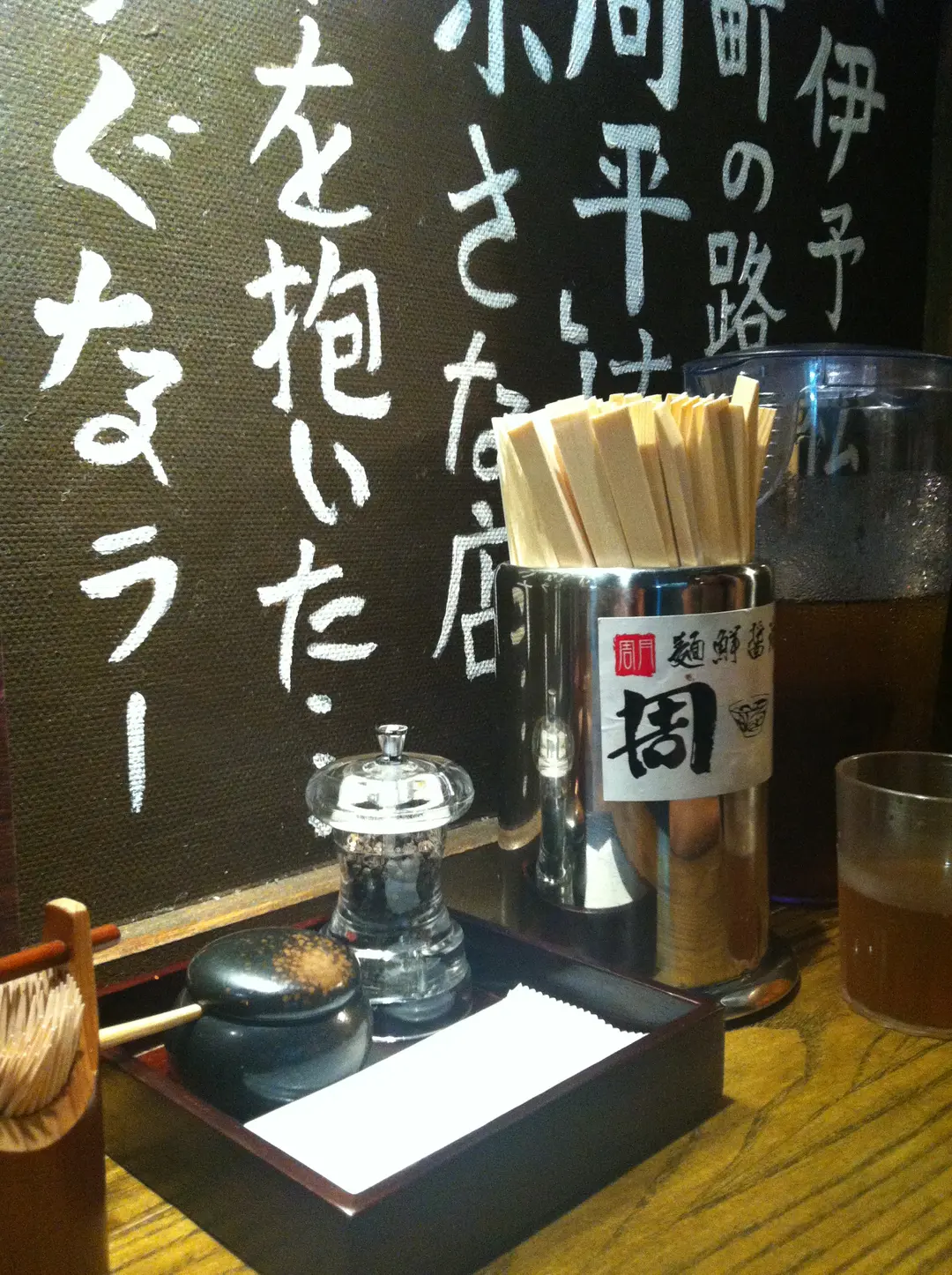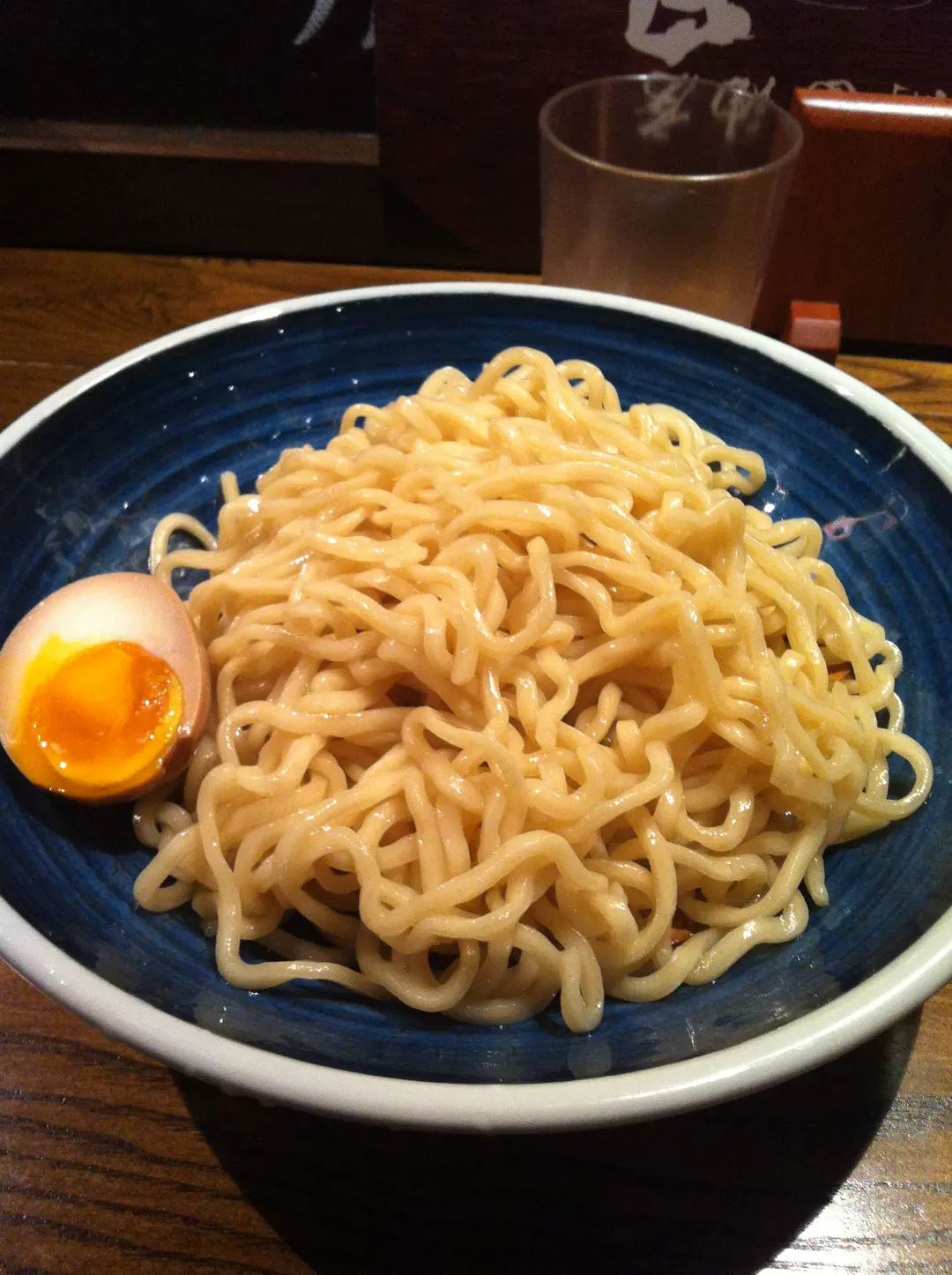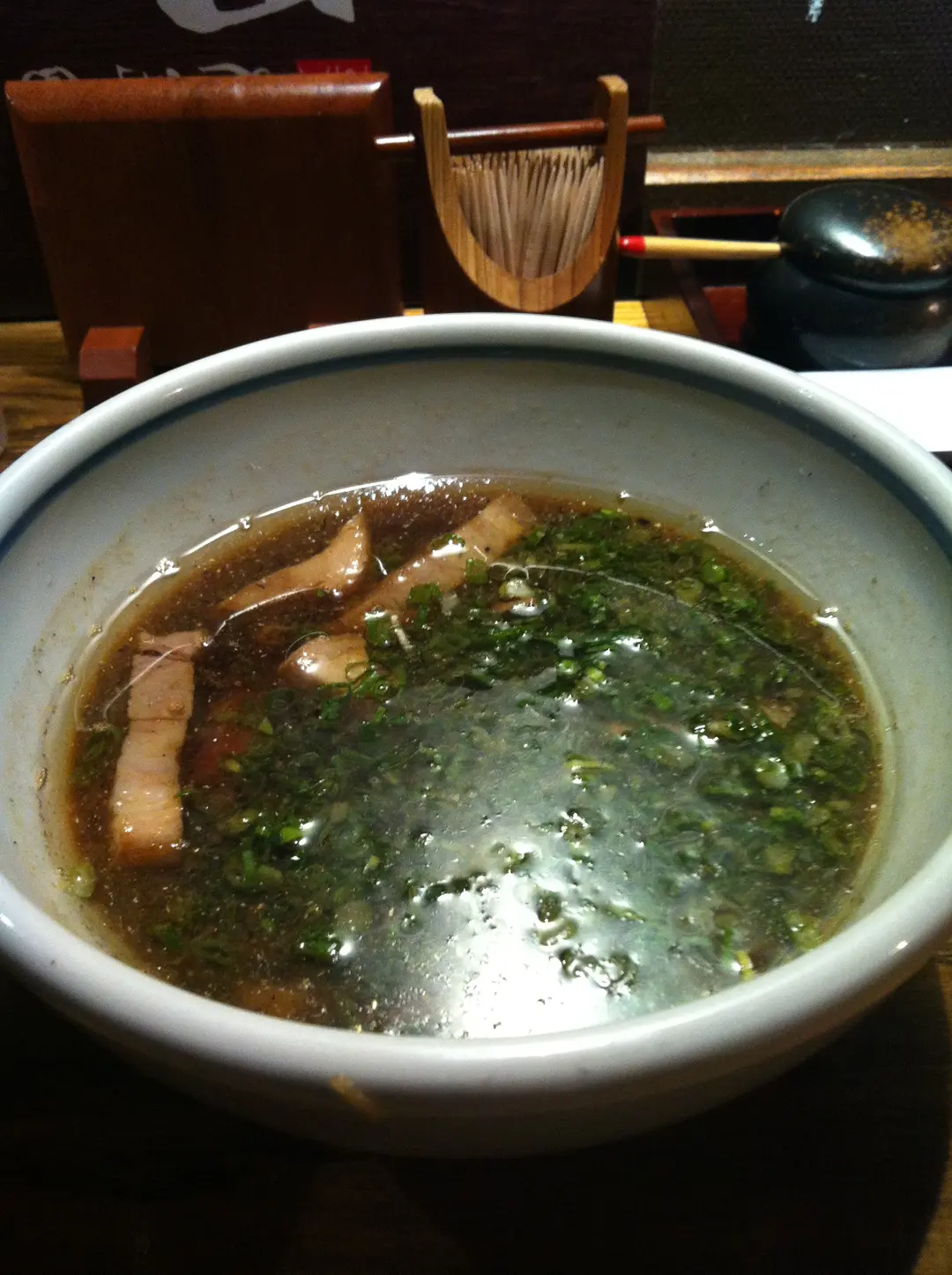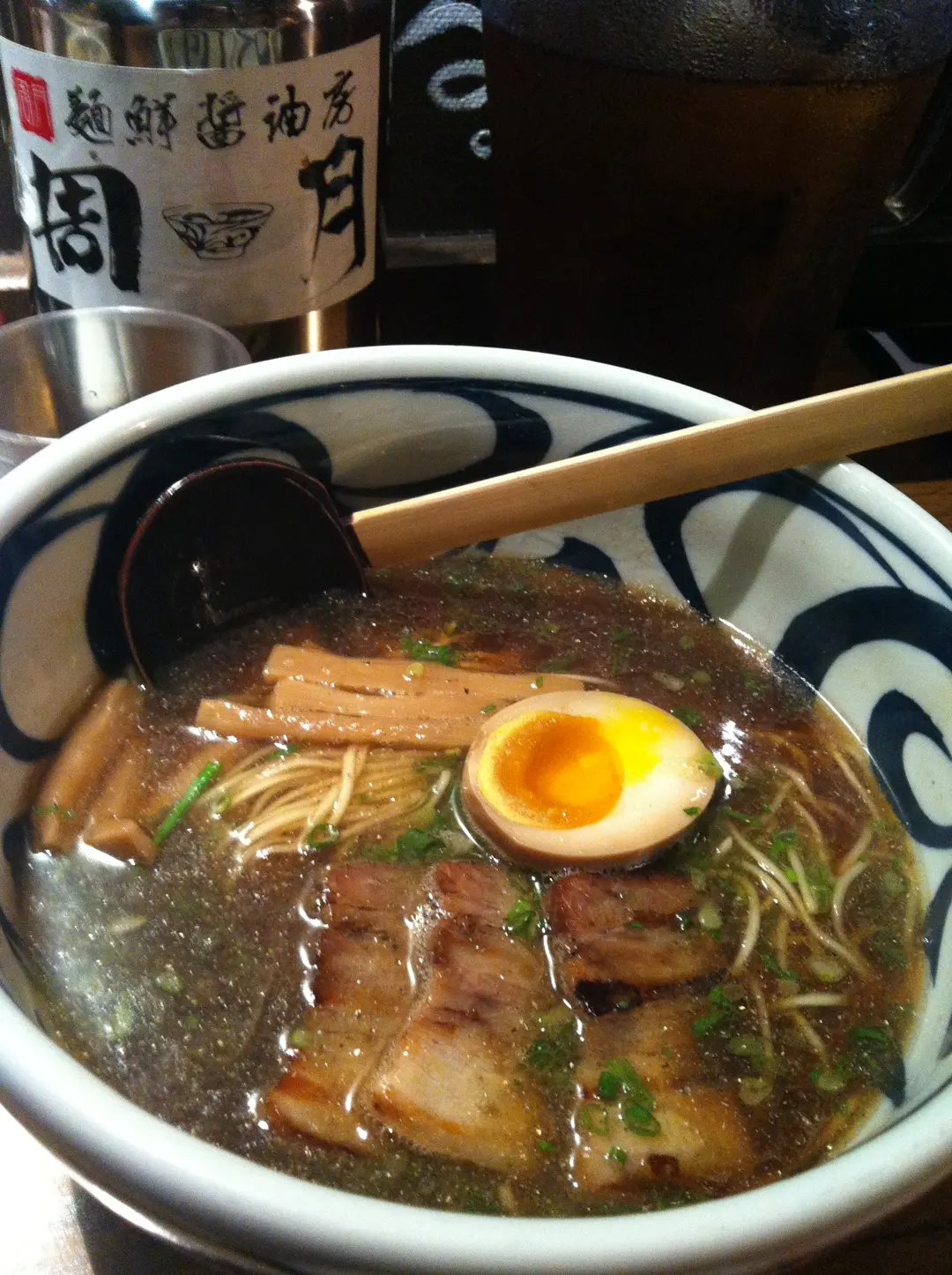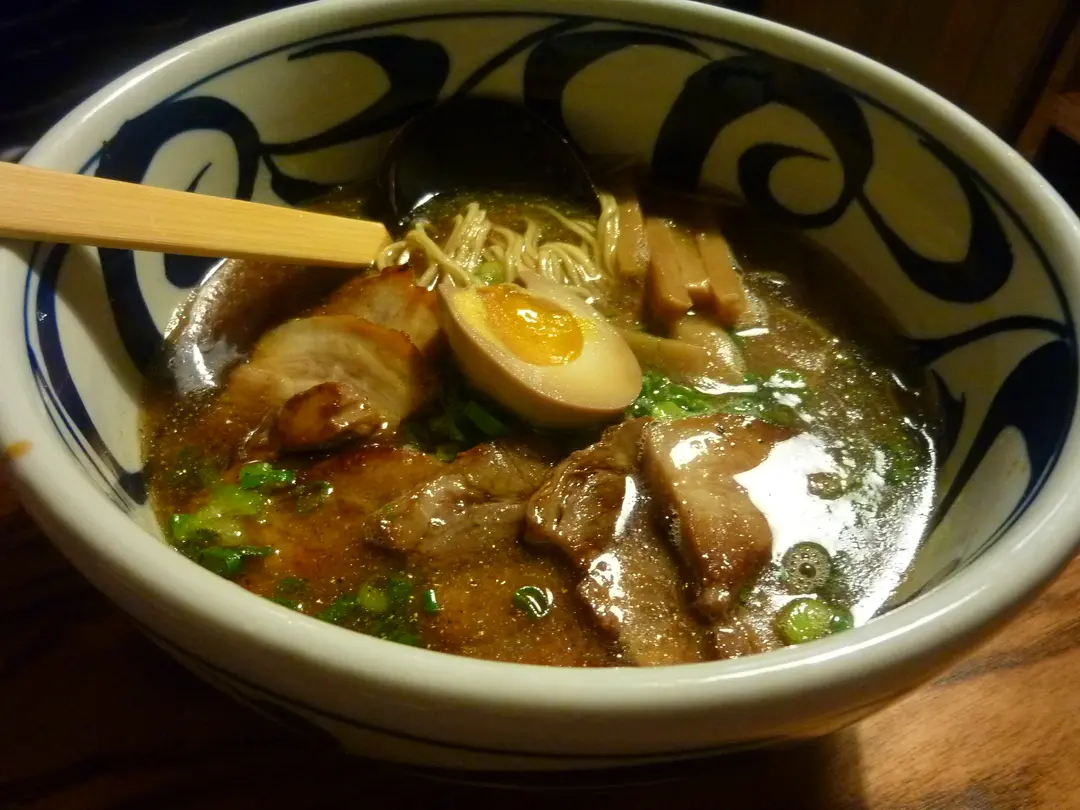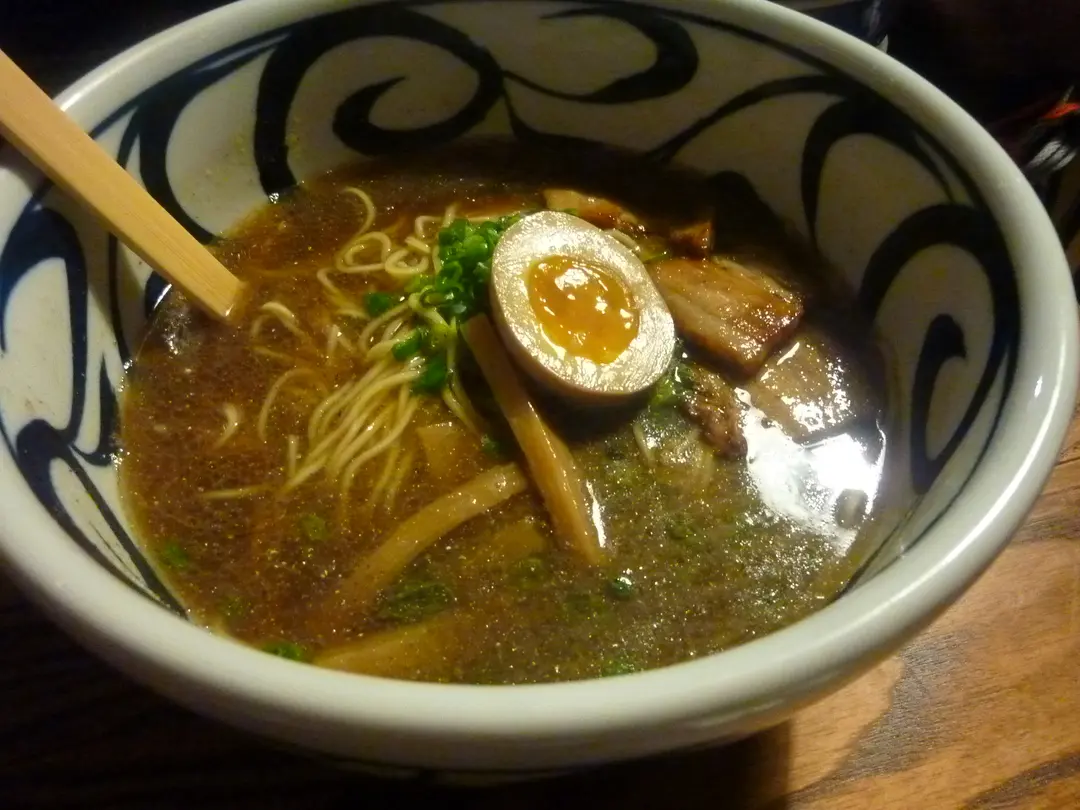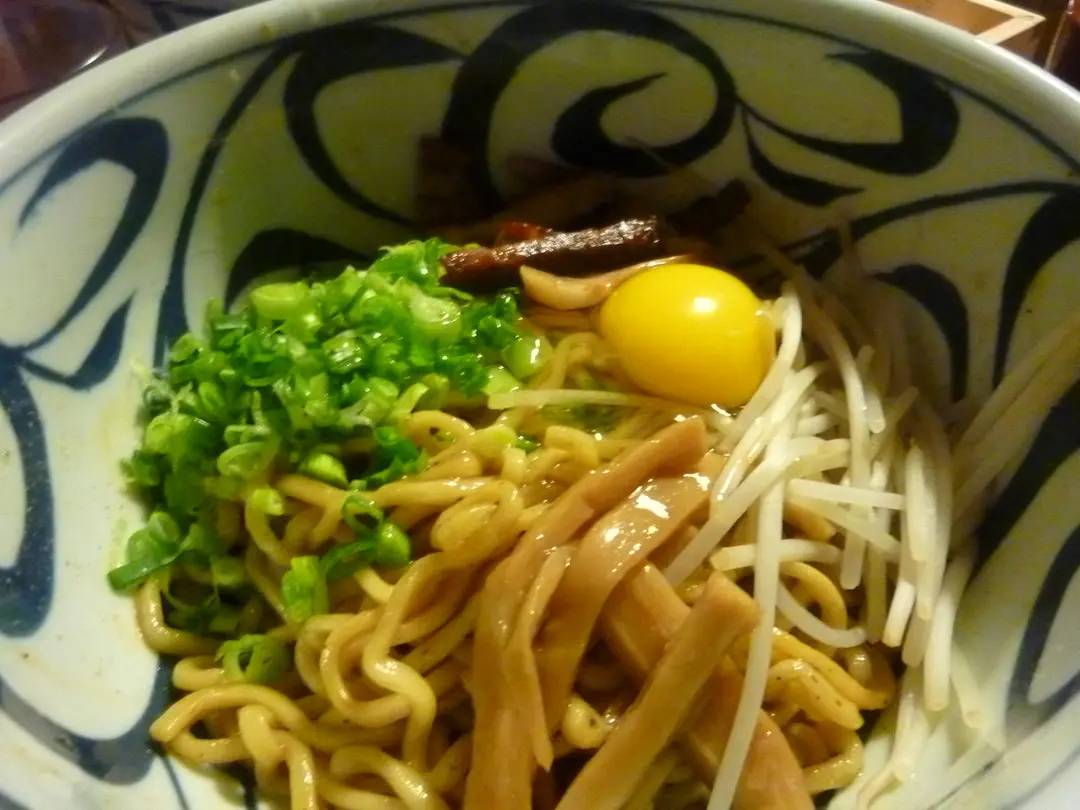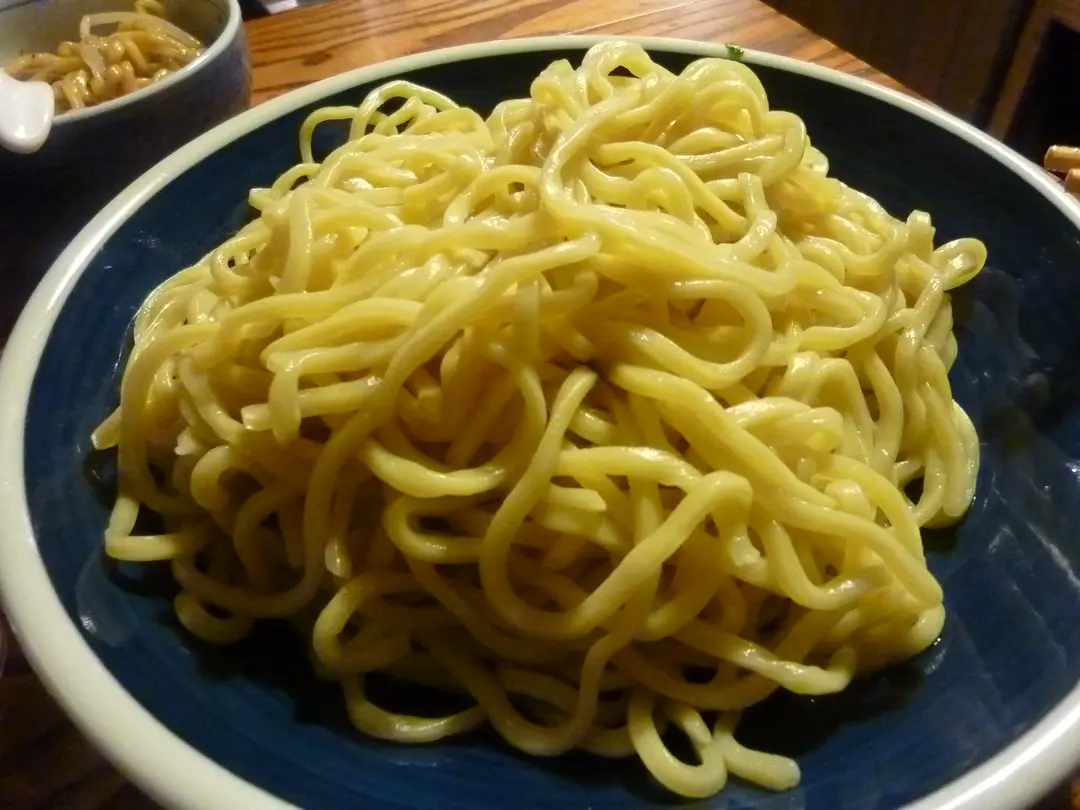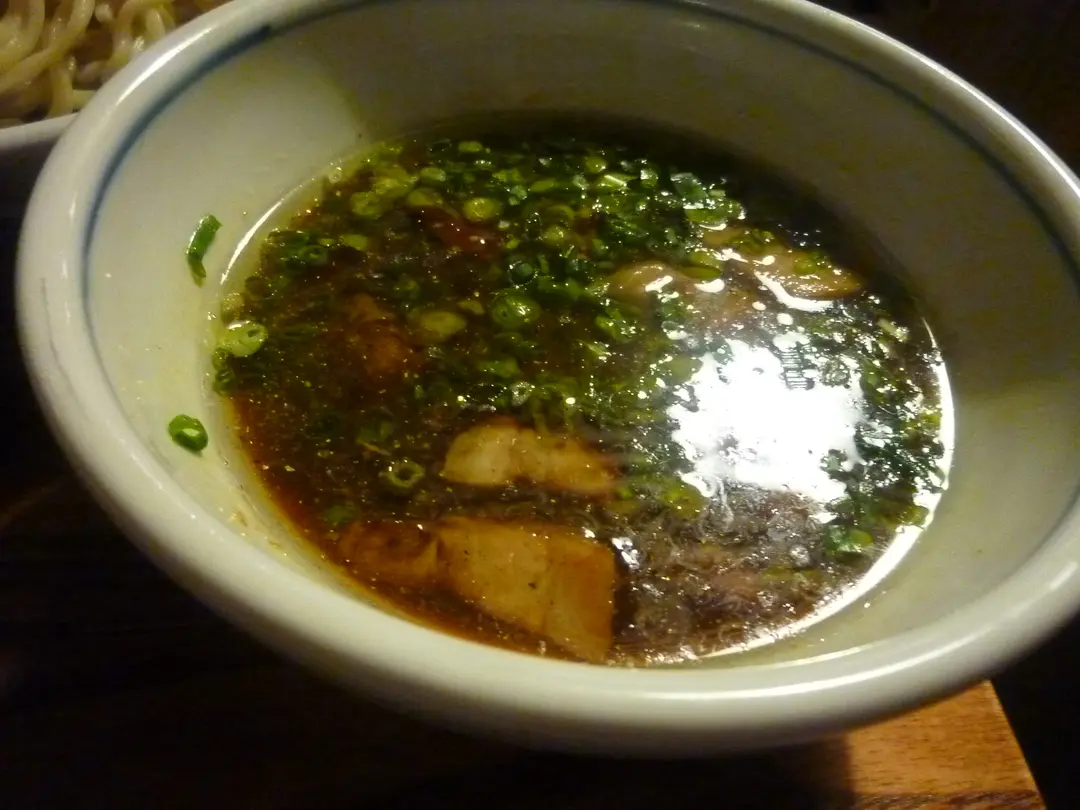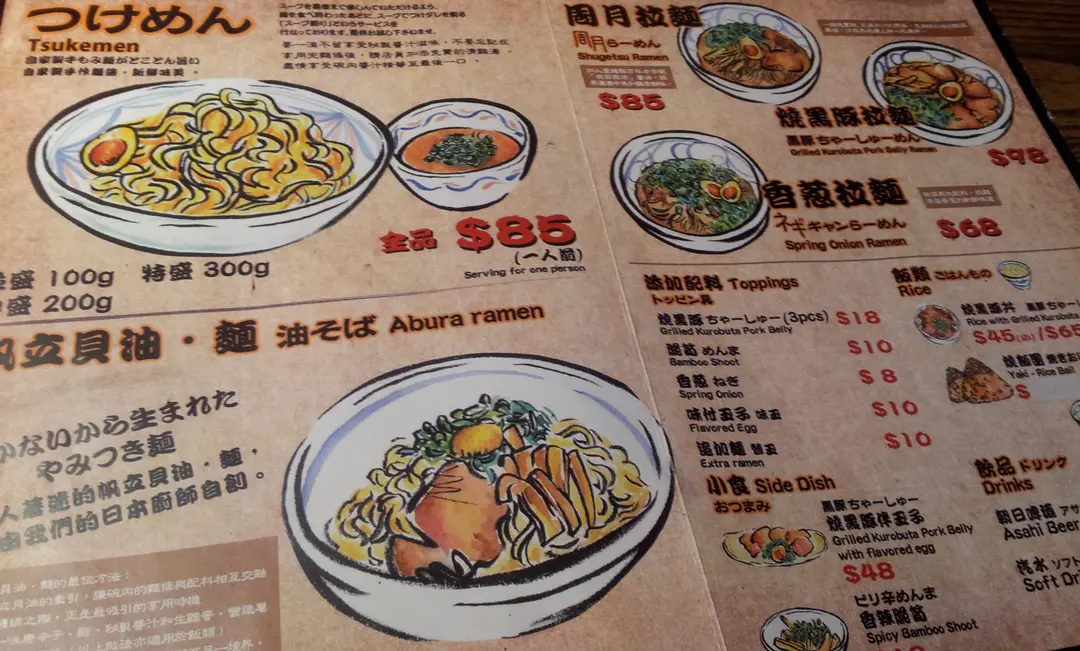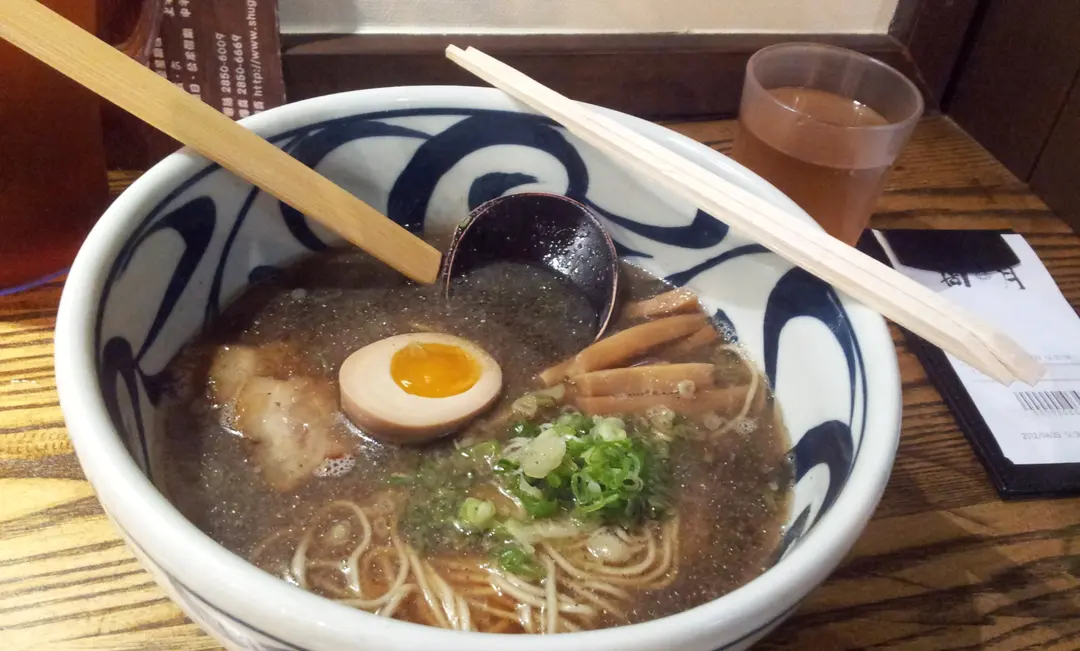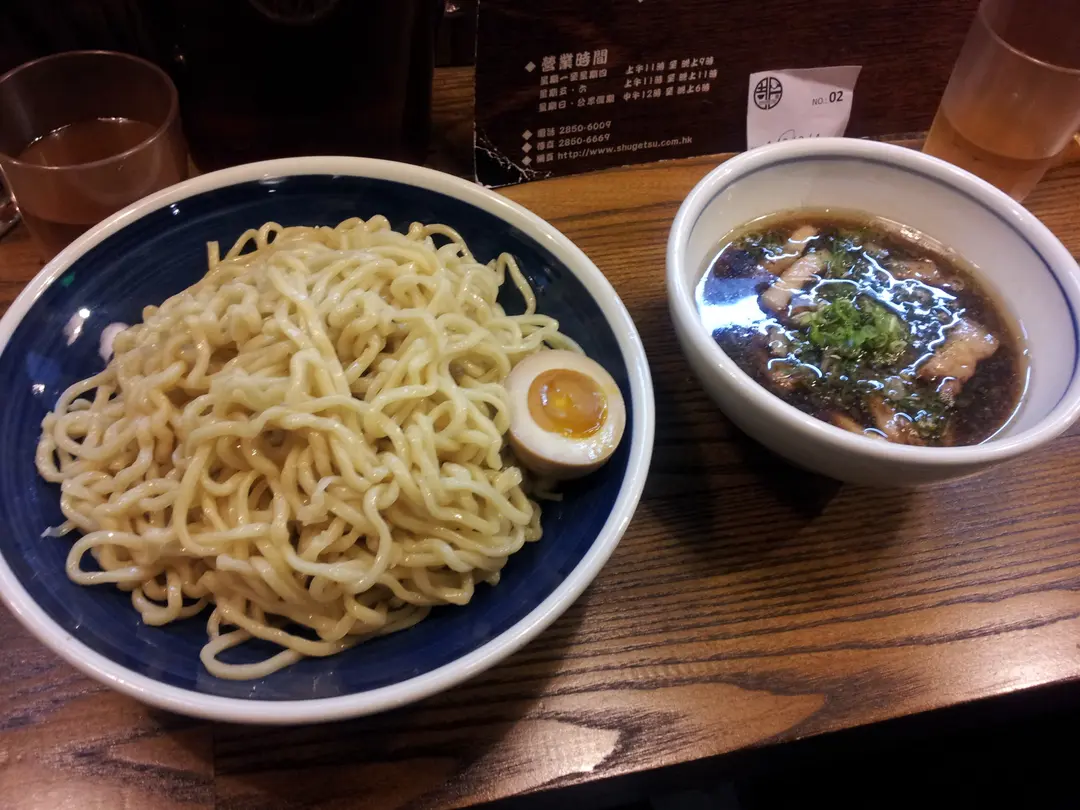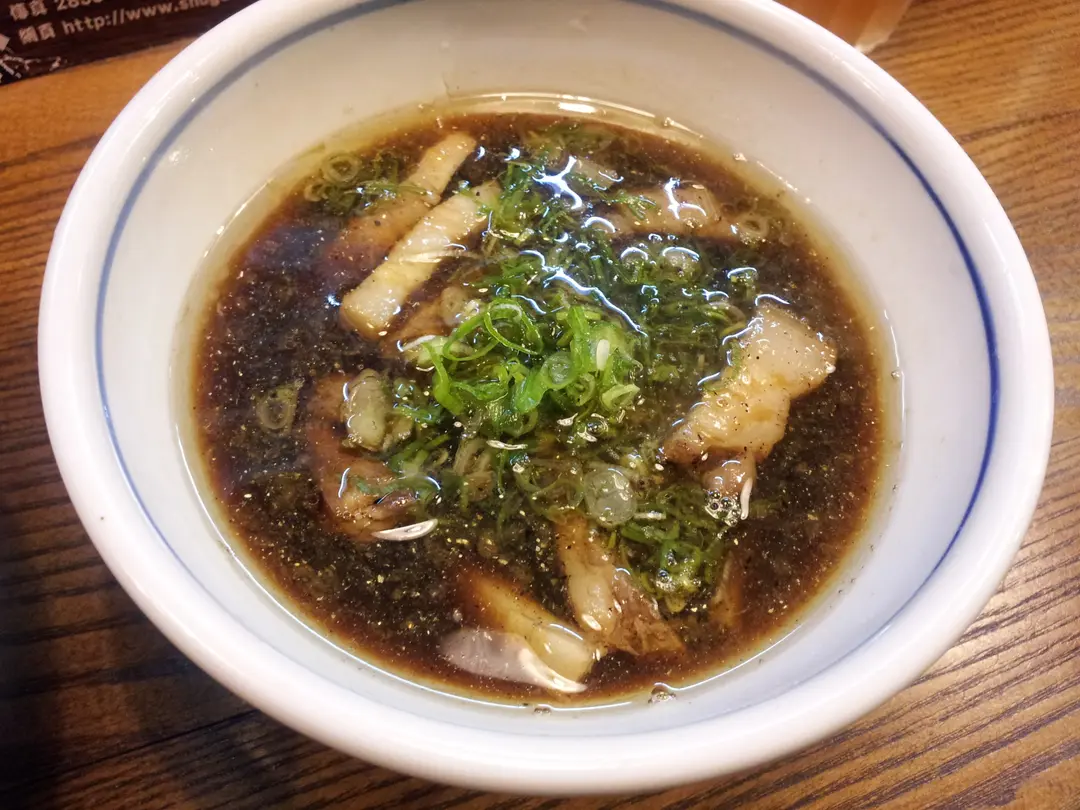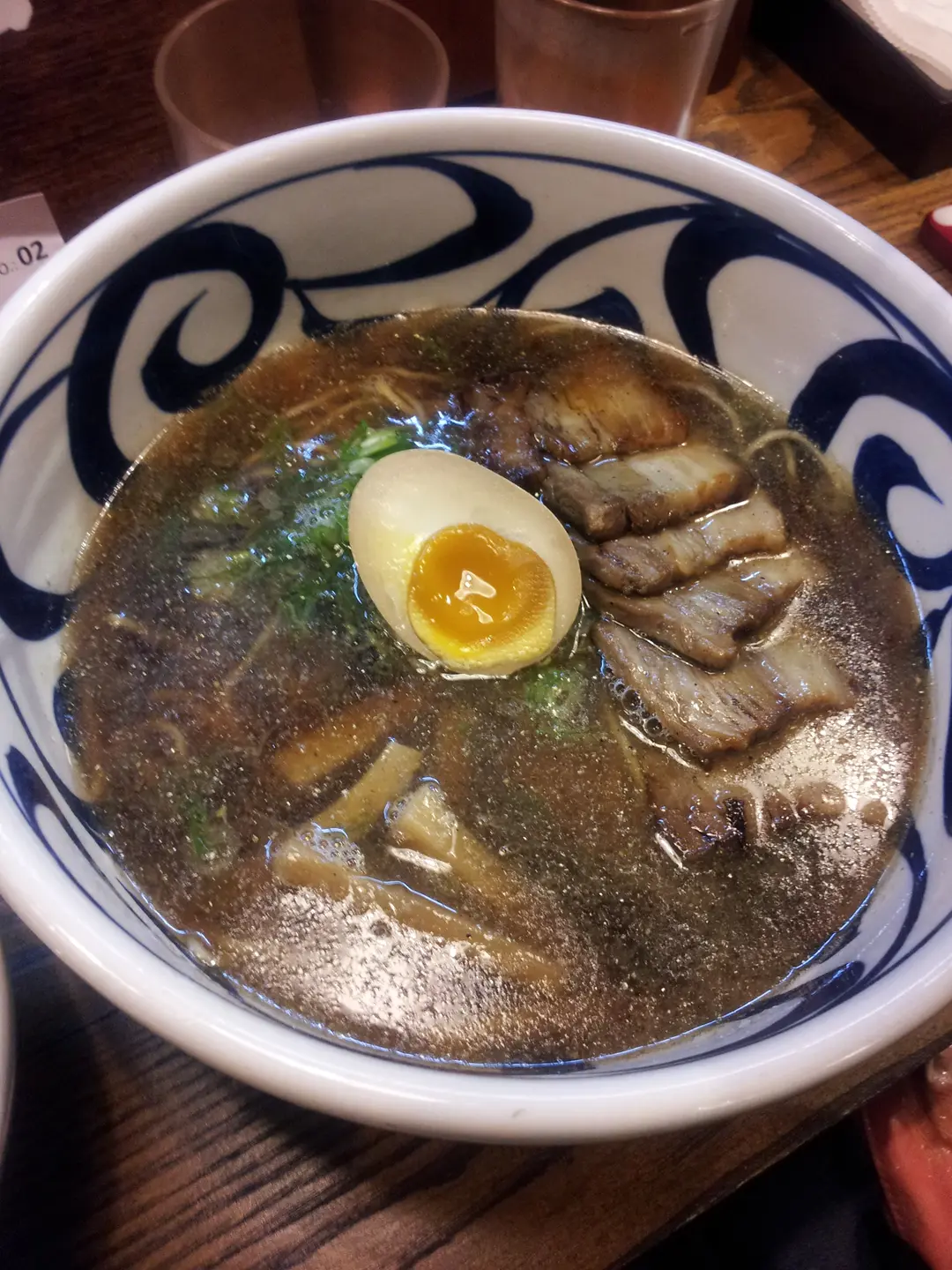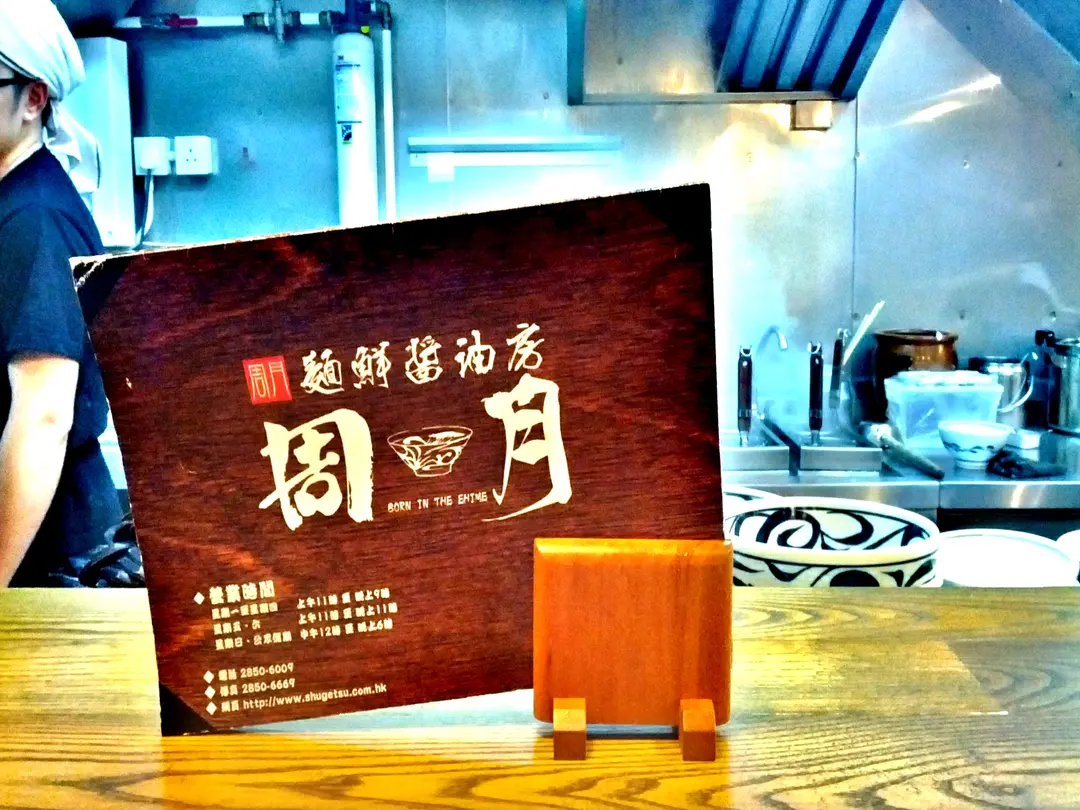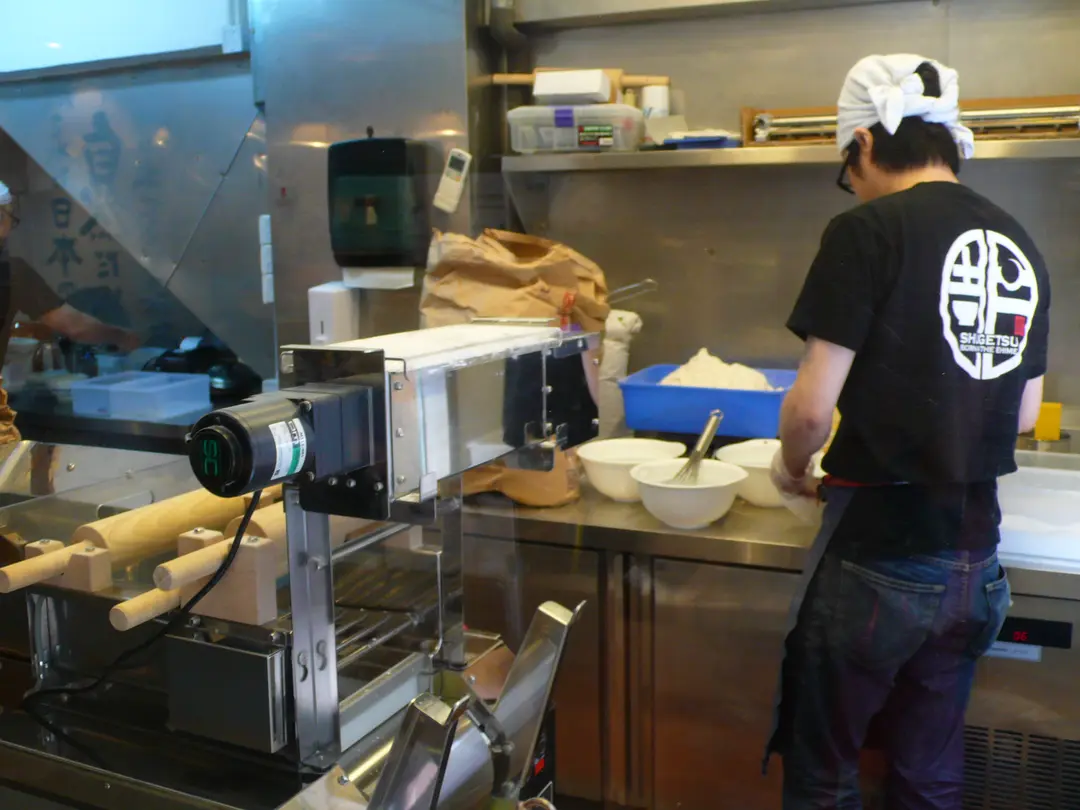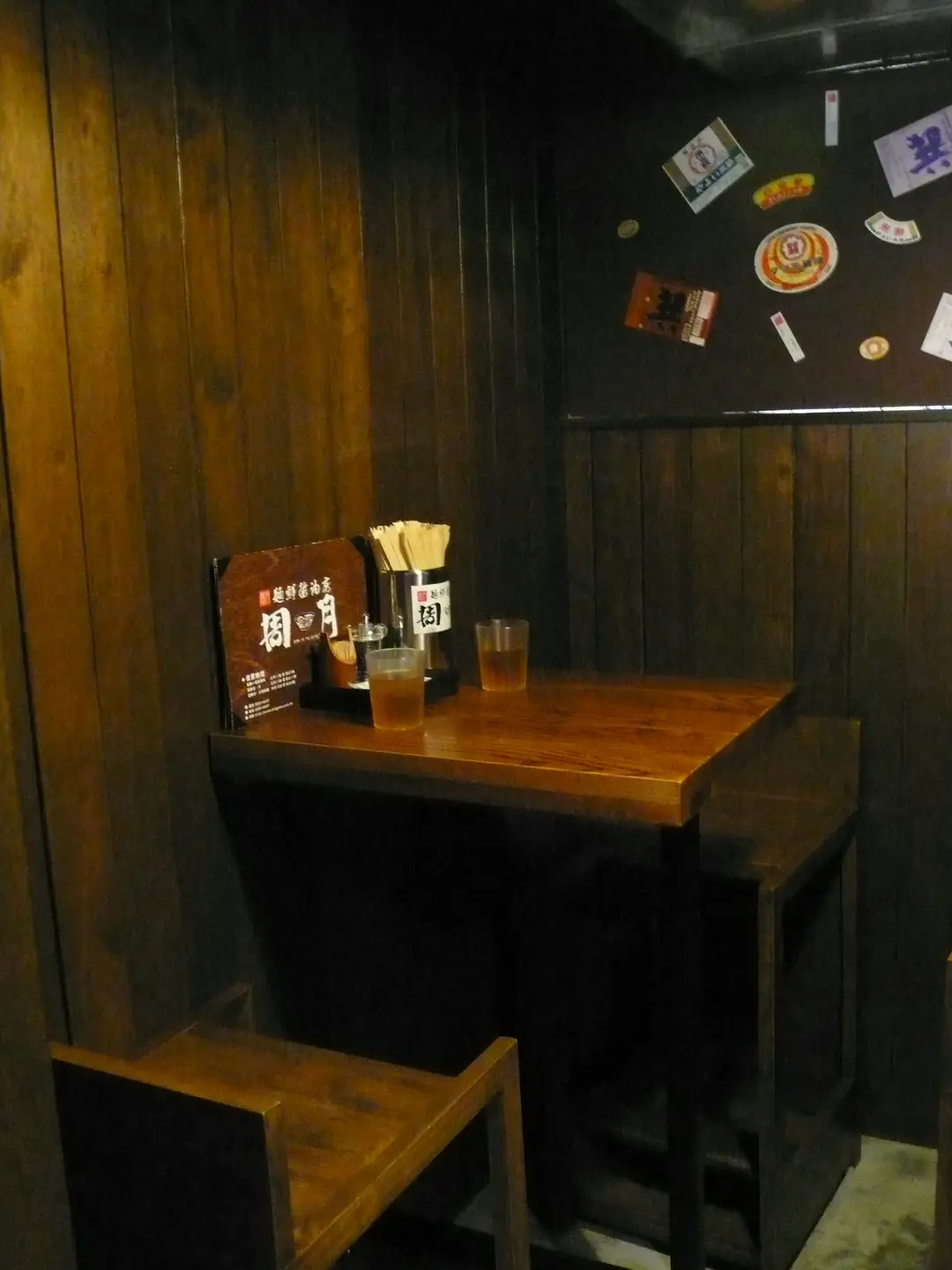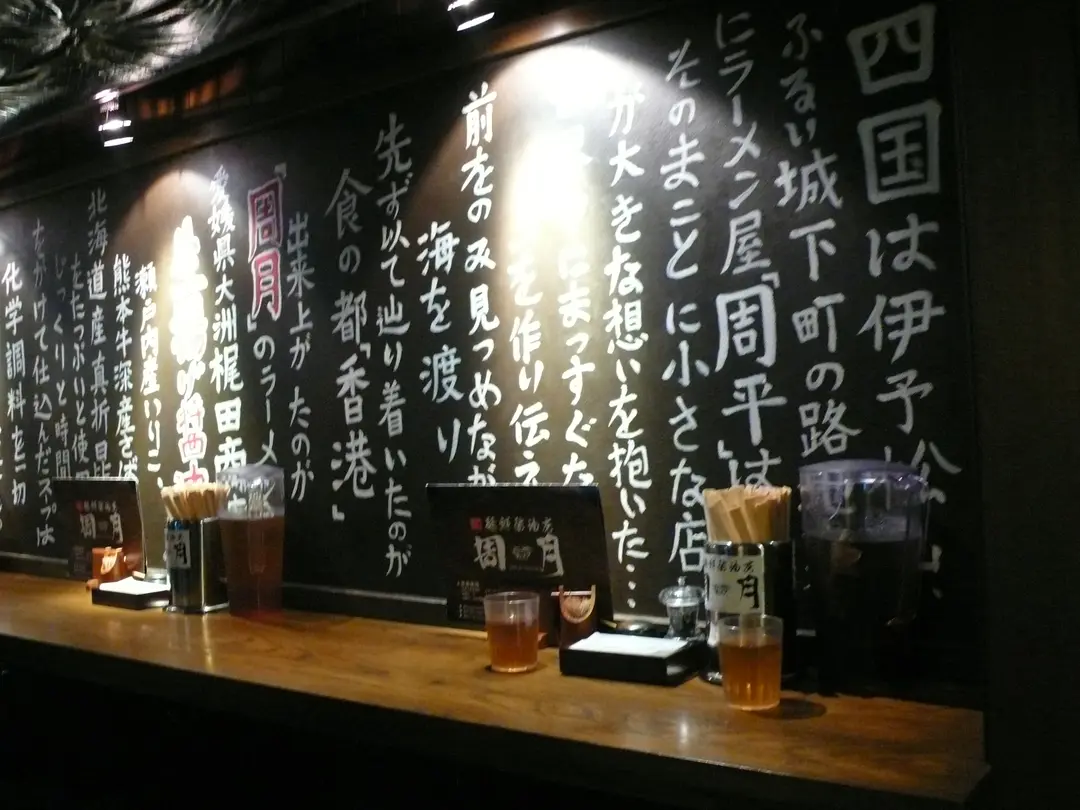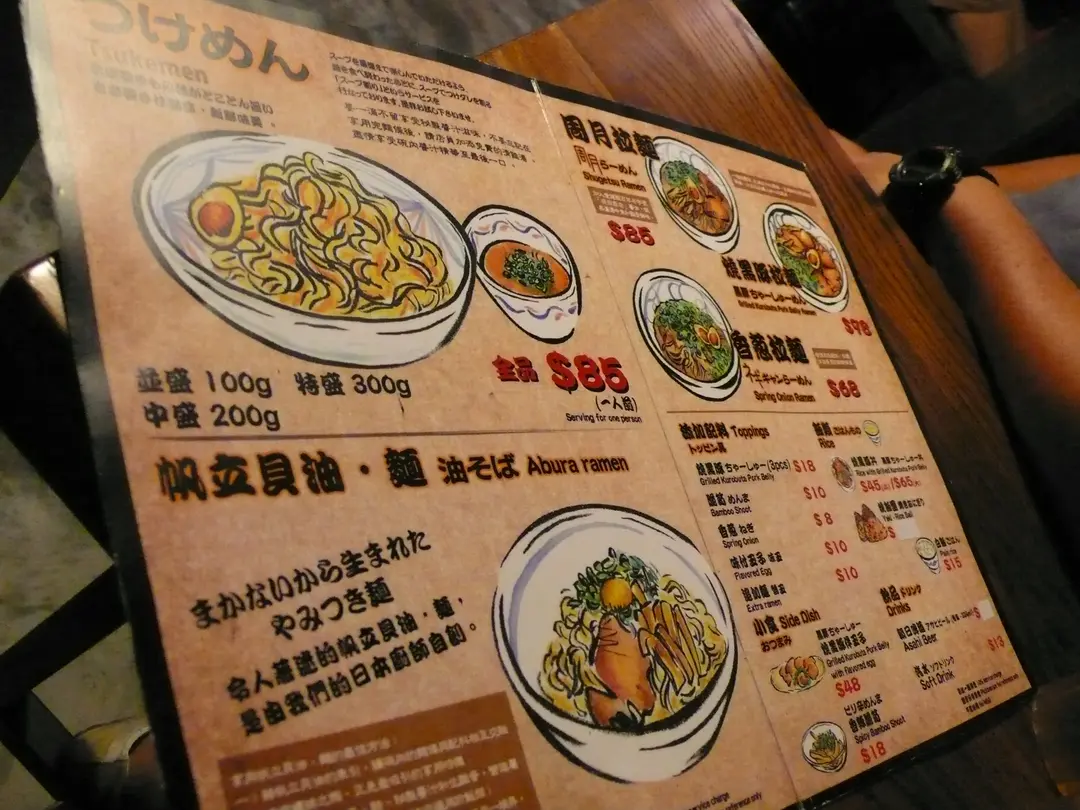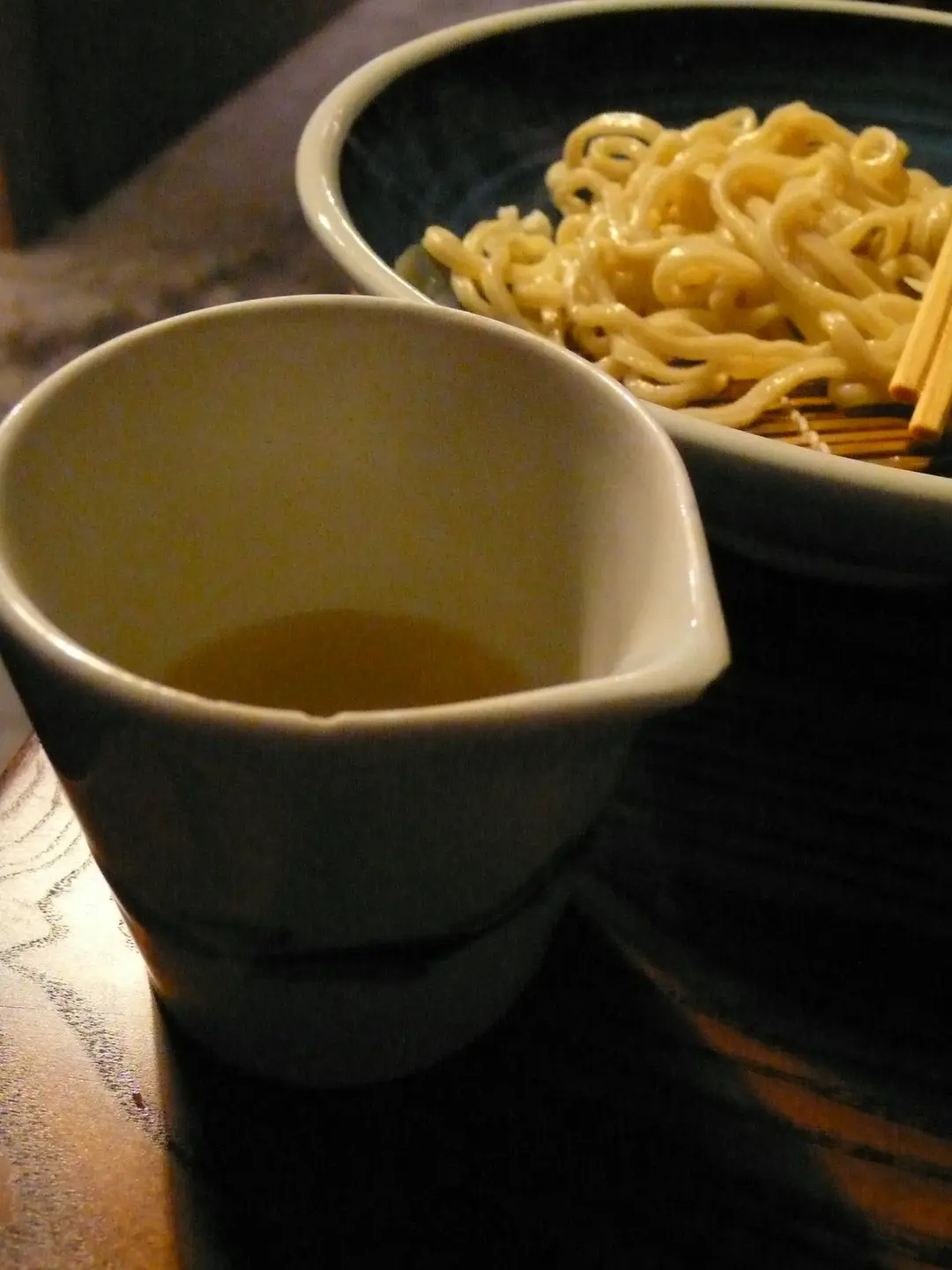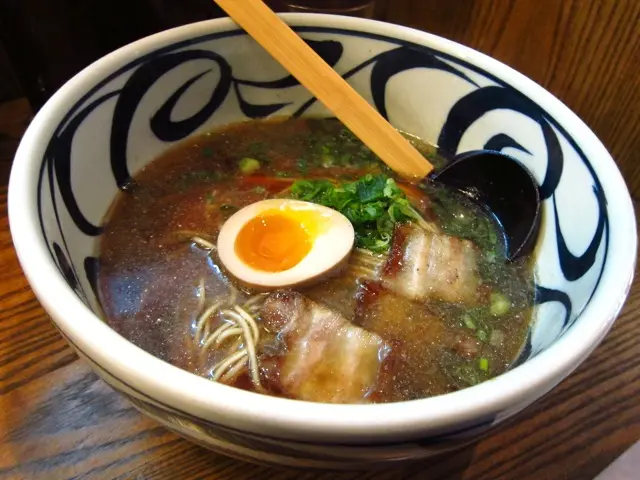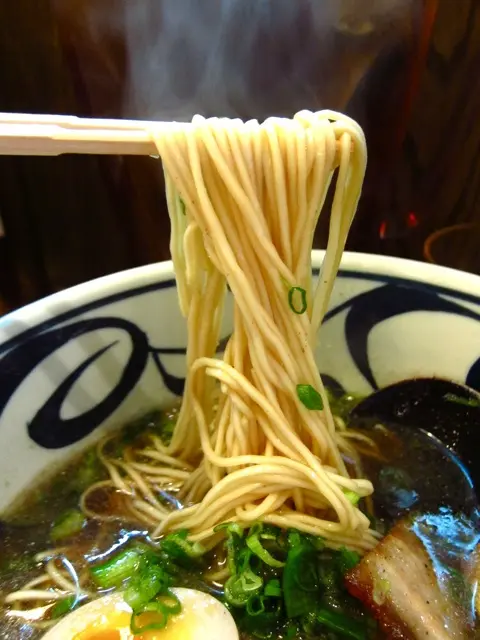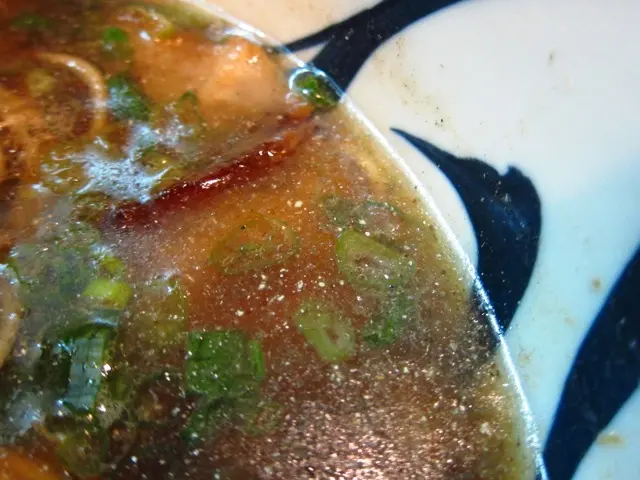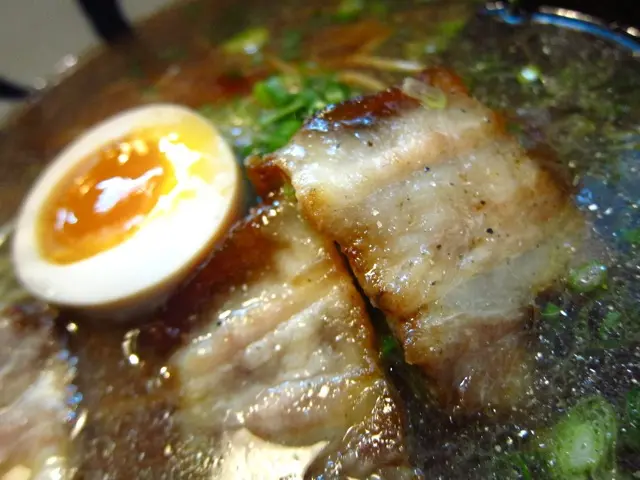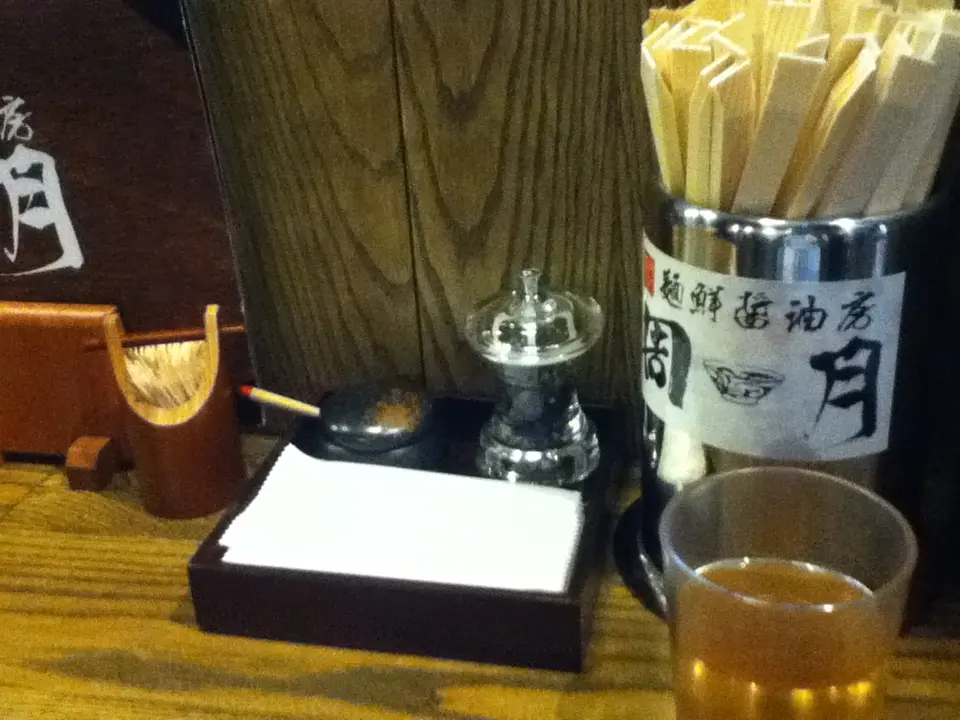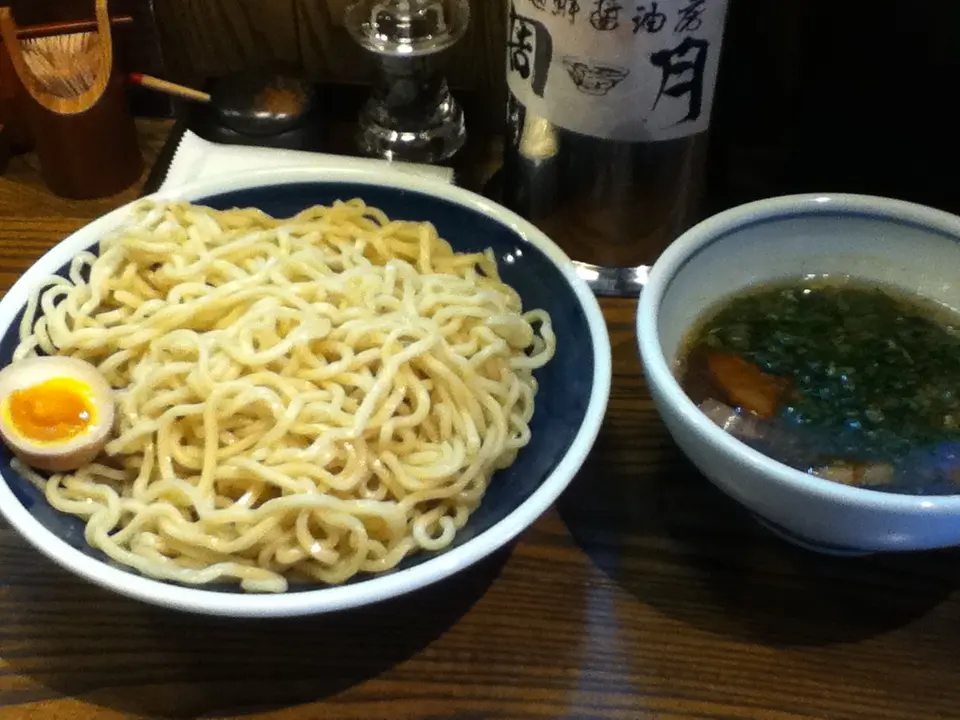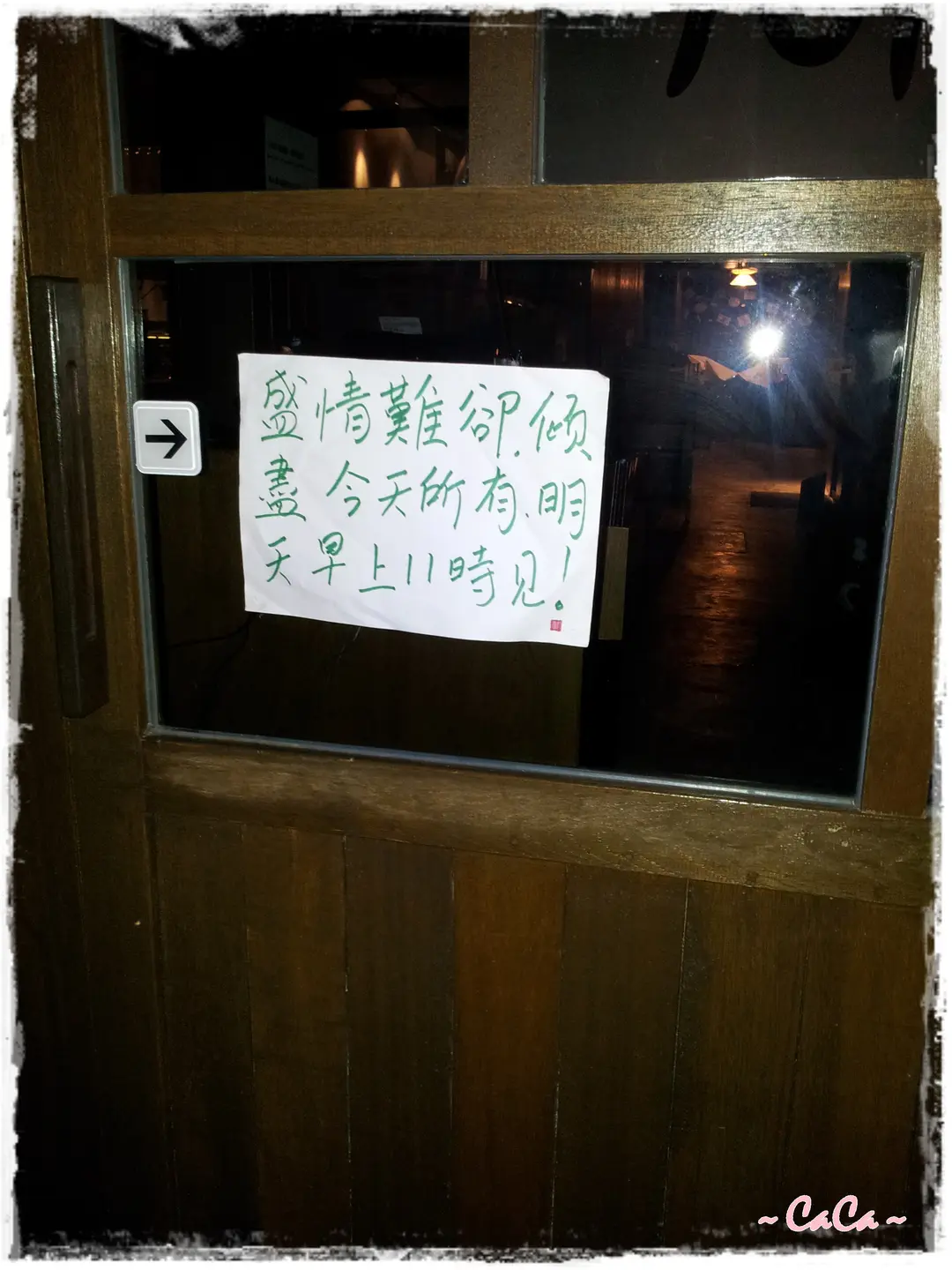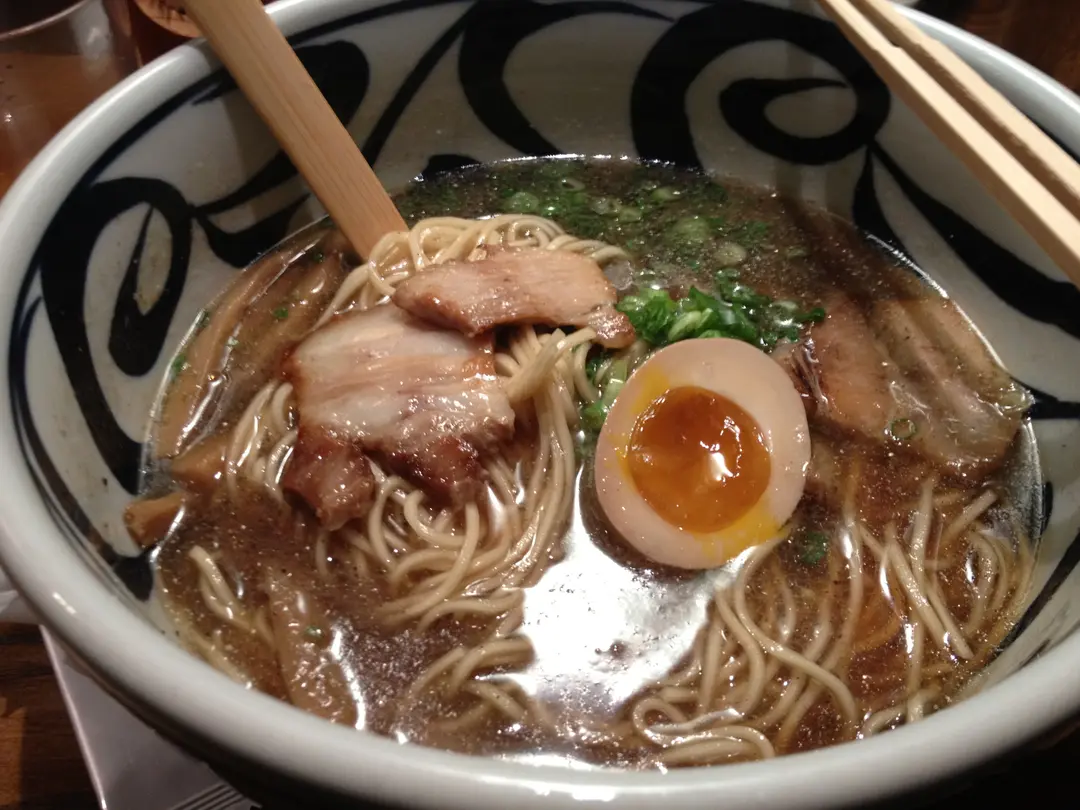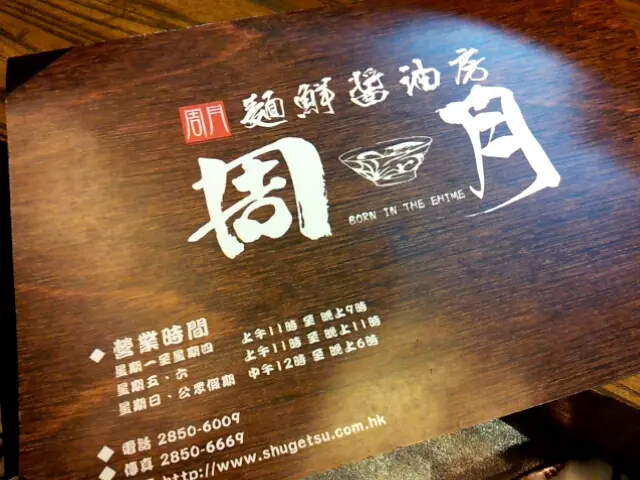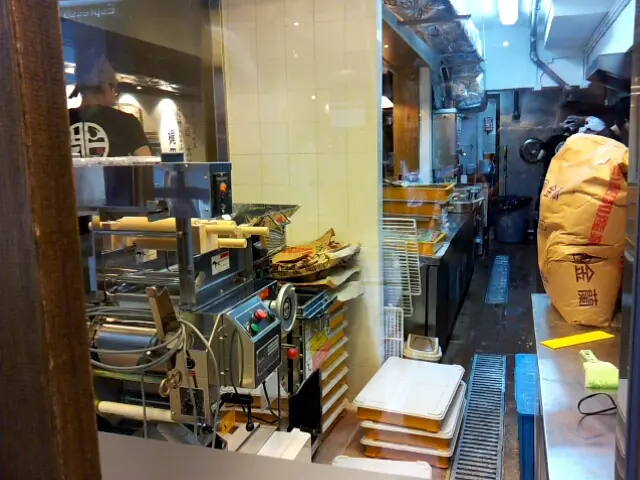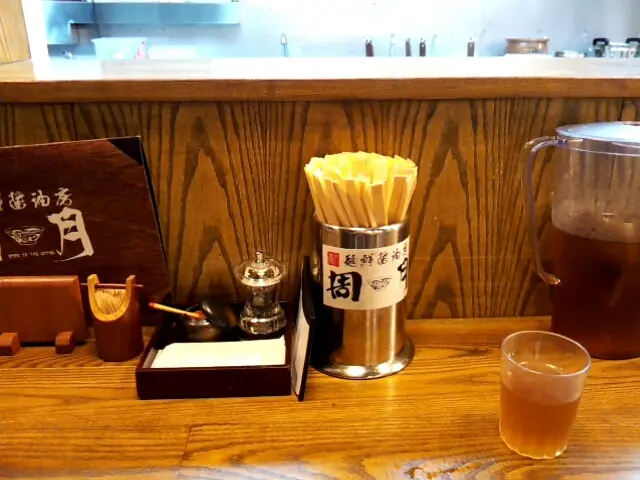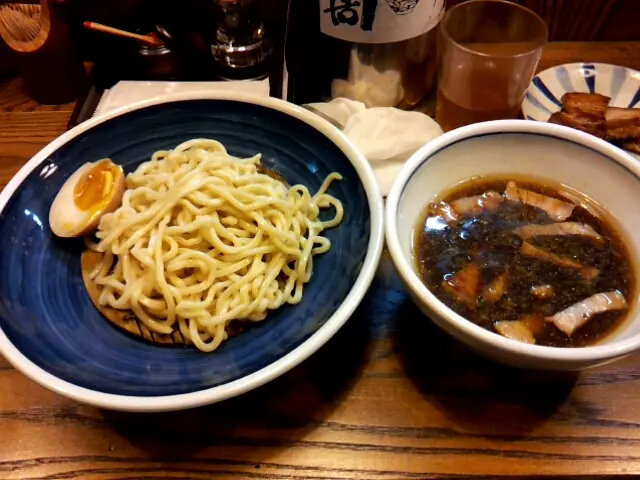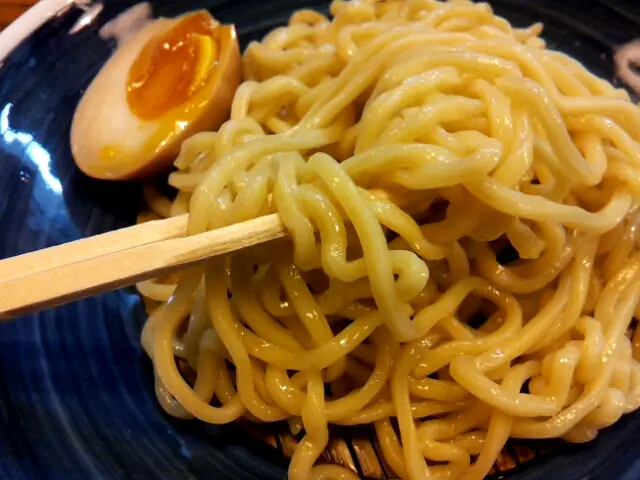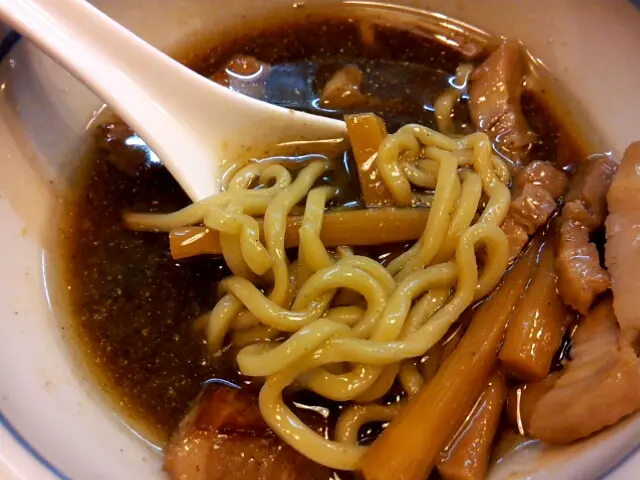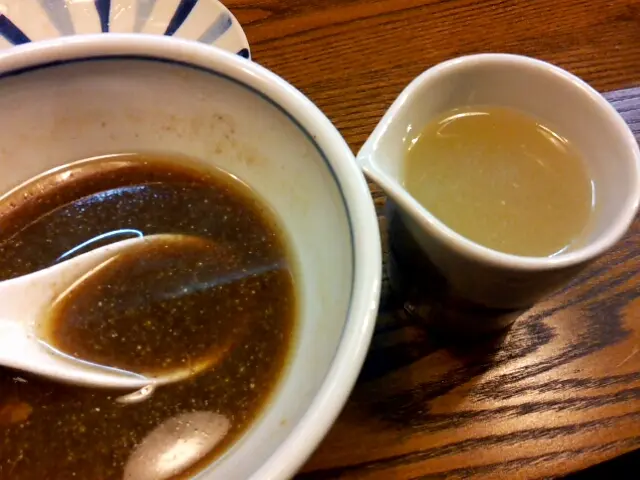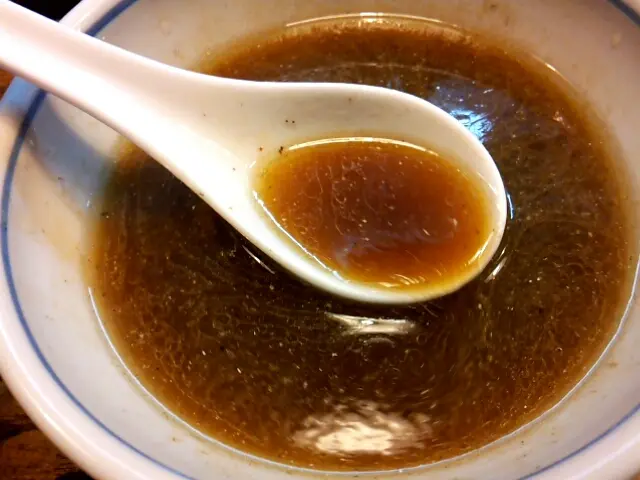更多
2012-05-12
185 浏览
周月在蓮香樓附近。路盲的我在大熱天時幾經辛苦才找到。深色的木為主調,環境舒式,位與位之間很寬敞。幸好冷氣夠勁!點了招牌沾麵及竹筍。等了一會麵才到。沒沾汁前試了一口 ......有麥香及蛋香,但實在太硬! 並不爽口。武藏的應該較淋 (但不太爽口)。拉麵"秀" 的沾麵較易入口,亦爽口。蛋唔錯。流心,但味道偏淡。醬油汁就好吃: 用超過140年愛媛県大洲梶田商店釀製的"生醬油" (即發酵和熟成後沒有經過加熱的醬油)為主的汁。味道不過濃,不嗆喉。甘口清香有餘韻。荵花亦有醒味之用。切碎了的叉燒軟硬適中。有烤過的痕跡。比"來"好食多倍。全靠醬汁我才可成功吃完整碟麵。200g 都好飽肚。多數人應覺得夠。吃完整碟麵後,店方會提供雞湯。但雞湯並冇特別雞味。除令醬汁淡一點以供飲用外,作用不大。竹筍應用了韓式小辣粉及豆板醬,偏咸 - ok 而已。HK$123 (連竹筍及加一)。並不便宜。對周月的拉麵 (九州系的幼麵) 反而更有興趣。服務很好。明顯訓練有素。笑容可恭。特別是一位"Gigi"。見我滿頭大汗,立即細心地拿了紙巾及冰水來。連在旁的男侍應亦低聲用日語對她說"很善良呢!"...醬油,服務及環境搭救。 如在
點了招牌沾麵及竹筍。
等了一會麵才到。沒沾汁前試了一口 ......
有麥香及蛋香,但實在太硬! 並不爽口。
武藏的應該較淋 (但不太爽口)。拉麵"秀" 的沾麵較易入口,亦爽口。
蛋唔錯。流心,但味道偏淡。
醬油汁就好吃: 用超過140年愛媛県大洲梶田商店釀製的"生醬油" (即發酵和熟成後沒有經過加熱的醬油)為主的汁。味道不過濃,不嗆喉。甘口清香有餘韻。荵花亦有醒味之用。切碎了的叉燒軟硬適中。有烤過的痕跡。比"來"好食多倍。全靠醬汁我才可成功吃完整碟麵。200g 都好飽肚。多數人應覺得夠。
吃完整碟麵後,店方會提供雞湯。但雞湯並冇特別雞味。除令醬汁淡一點以供飲用外,作用不大。
竹筍應用了韓式小辣粉及豆板醬,偏咸 - ok 而已。
HK$123 (連竹筍及加一)。並不便宜。
對周月的拉麵 (九州系的幼麵) 反而更有興趣。
服務很好。明顯訓練有素。笑容可恭。特別是一位"Gigi"。見我滿頭大汗,立即細心地拿了紙巾及冰水來。
連在旁的男侍應亦低聲用日語對她說"很善良呢!"...
醬油,服務及環境搭救。 如在附近,我可能會一試醬油拉麵。
It was not easy finding this shop for someone who can't read maps properly. I walked from Admiralty to LKF, walked along Yung Kee till I reached the Central escalator. I must have taken a turn to the left too early and ended up at Hollywood Road. The mistake was further aggravated when I realized that I was walking back towards the Fringe Club! At this point, I'm was thinking of an alternative place to have lunch, perhaps Hide-Chan, in which seats are usually available. Suddenly, I thought to myself, "what the heck, just try and find it". After another trek along Wellington Street (street where Yung Kee was located), I finally found it. It's almost next to "Lin Heung Tea House". Quite a long trek indeed!
Once I got inside, I was shown a bar seat. The ambience was good. Nice wood based modern decor, dim and with heavy air-con! Luckily the seats were pretty spaced wide apart and were quite comfortable. So I didn't have to further embarrass myself around other customers as I was sweating like a pig.
Service:
The kind waitress, who was friendly and smiled every time she interacts with customers, I believe called "Gigi" (as printed on the receipt), perhaps noticing that I was still sweating seriously like a dehydrated pig, and frantically wiping the sweat off with a not so absorbent handkerchief, offered some tissues and a glass of ice water. That was supremely welcomed! Good service and thanks again, Gigi さん!)
...Even her male colleague, said silently - or so he thought - to her in Japanese "優しいね" , i.e. how kind of you......
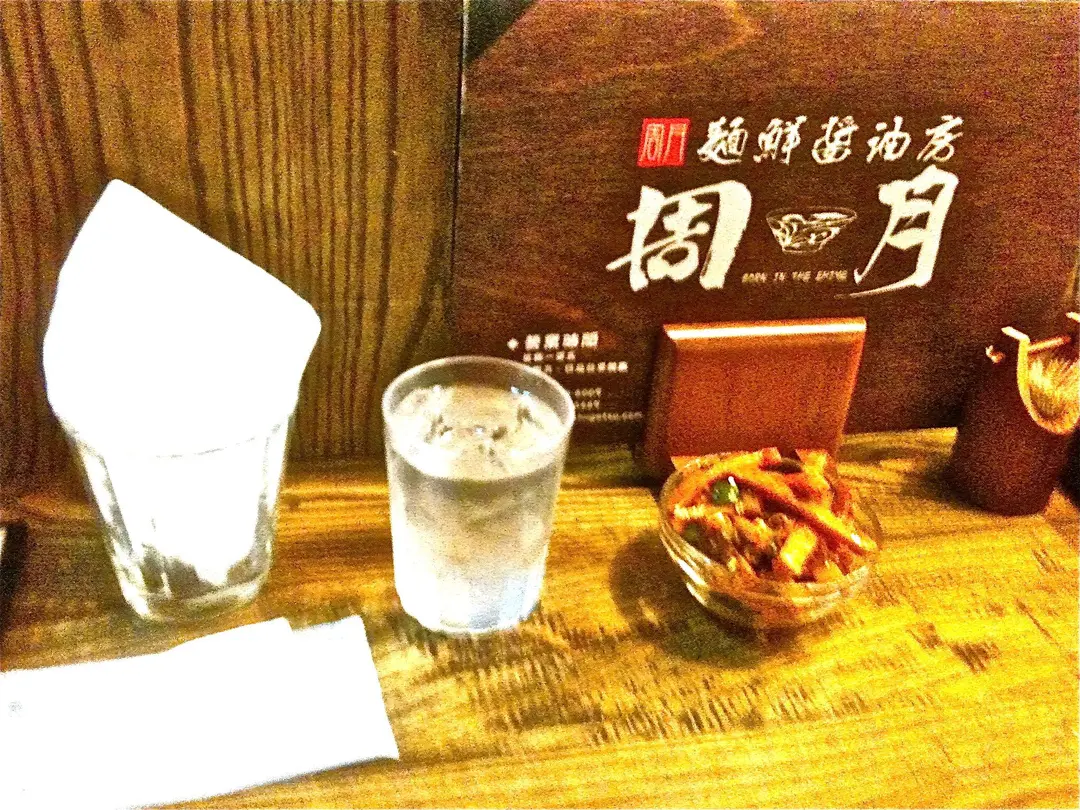 I'm pretty sure he didn't expect two things:
I'm pretty sure he didn't expect two things: (1) My superhuman listening skills in picking that up - they were about 1.5 meters behind my back with a noisy background.
and
(2) that I understand basic Japanese...
Moral of the story: Don't speak behind people's back.
The same male waiter, I'll call him Mister A, then approached me and politely asked whether I'd like an introduction. After a few seconds thought, I figure, although I'm pretty sure what I'd like to order after having reading all the useful reviews from previous commentators anyway, I'd like to see how the staff would introduce their own products and perhaps learn something new too.
Mister A did a pretty comprehensive introduction of their signature tsuke ramen in a clear and concise manner. I asked him what the tsukemen sauce was made of and was given the not entirely useful answer of "soy sauce and chicken soup". I spared him from introducing the soup ramen on the next page of the menu as the general information printed on the menu was quite sufficient. Anyway, well done and thanks.
Actually, before my second attempt to locate this shop, I wanted to try their Shoyu ramen in soup as I'm not a big fan of tsukemen anyway and their soy sauce seemed to be a really special type of soy sauce in existence for more than 140 years! Σ(゚д゚lll) But after my second attempt to locate this shop at midday in summer, and at the brink of dehydration, I thought (wrongly) that a cold bowl of tsukemen wasn't such a bad idea after all! So that was what I ordered - the tsukemen, their signature ramen.
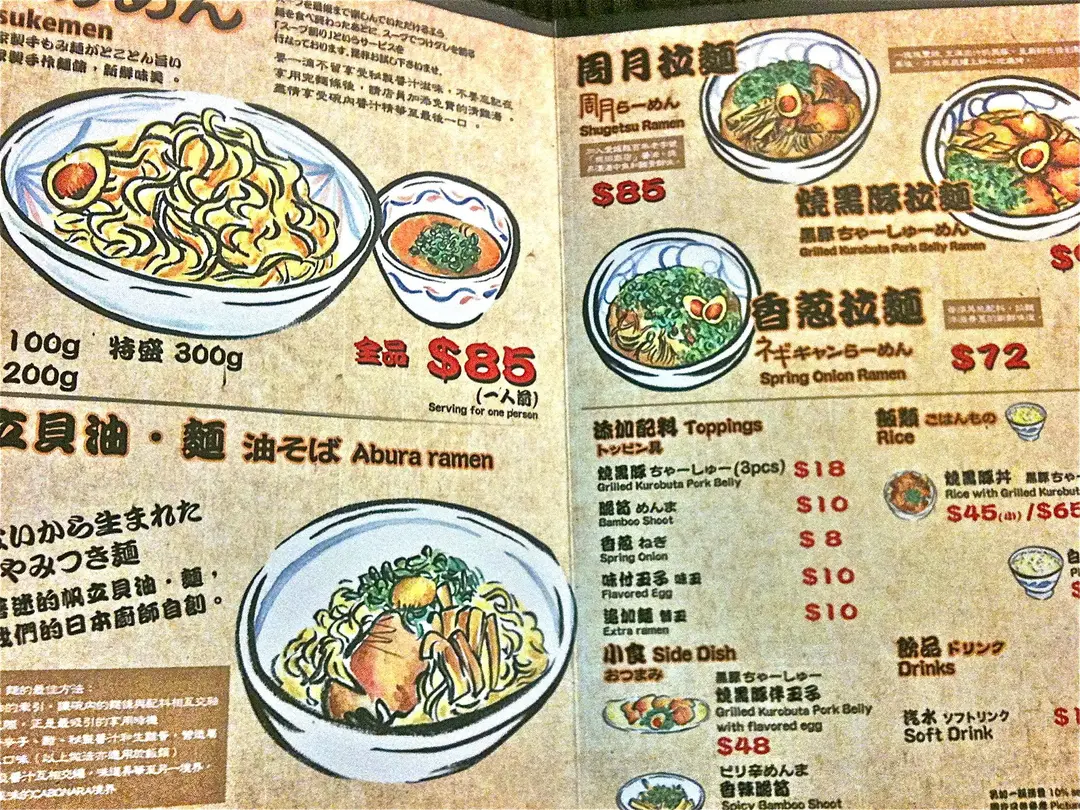 I was gently reminded by Mister A that the traditional style was to have cold noodles with hot sauce. That's what I ordered too.
I was gently reminded by Mister A that the traditional style was to have cold noodles with hot sauce. That's what I ordered too. I chose 200 g noodles. The price of the noodle was the same for 100g, 200g or 300g. I'm quite bad at mathematics so I'm not quite sure what 200g means. I just chose what seemed to be the "default" version.
I also ordered a portion of spicy bamboo shoots just to whet my appetite in the hot and humid weather. The bamboo shoots were not too spicy. It seemed to be marinated with Tou Ban Chang and some Korean Chilli powder. It wasn't too spicy and on the salty side. The spring onions didn't add much to the taste. It was just OK.
Not the noodles:
The house made noodle, apparently made daily by the noodle machine placed right at the entrance with Japanese flour - came after a 8-10 minutes wait, which seemed a bit long considering the fact that one only has to boil the noodle cake a bit as there was no broth with the tsukemen, which I guess should be where all the time and trouble lies.
I tried the noodle without dipping it into the sauce first - bad idea. It had a strong wheat and egg taste to it. The texture was too hard though. Definitely not something which I could just slurp and swallow in one go - unless I want to go straight to a hospital. It's harder that the thick Japanese egg noodle served at "Hide-Chan", which was a lot softer and chewier than here, and also "Menya Musashi" - they also served tsukemen (and appeared to have used the same noodle for their ramen too!)
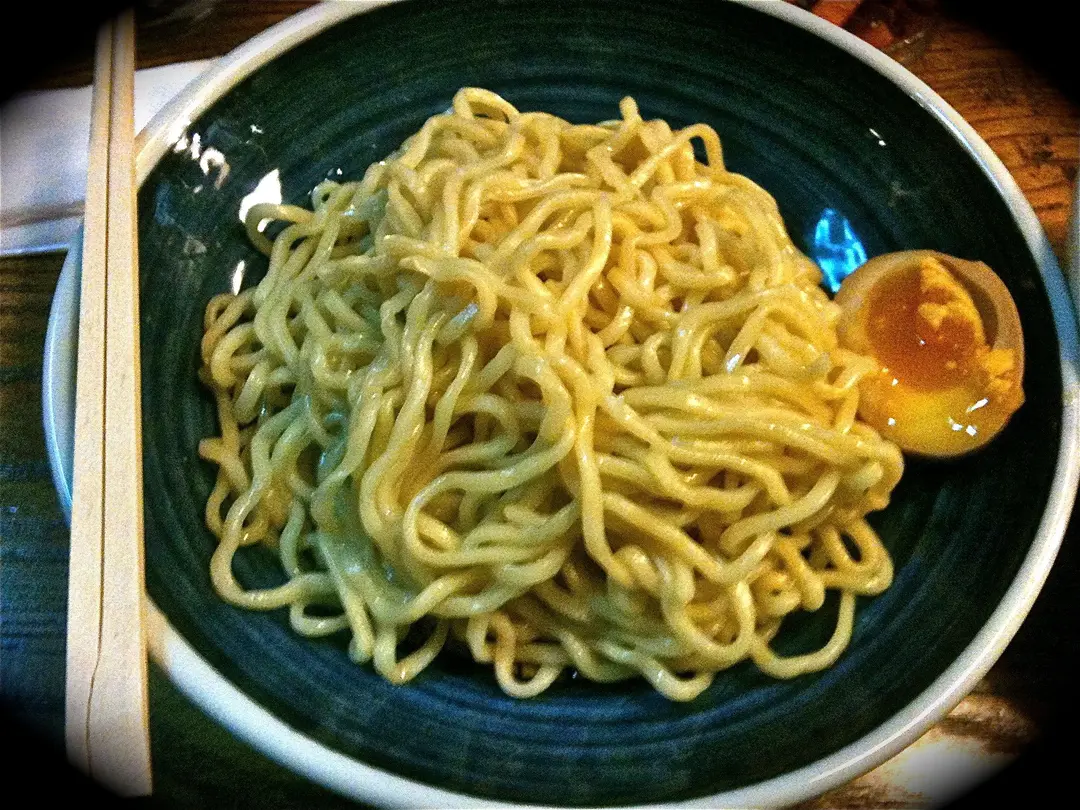 According to the free I-phone application "Kotoba!" , Japanese dictionary which you could download for free (more than 20MB), Tsukemen meant "cold Chinese noodle dipped in sauce". So comparing it with Chinese noodles should be fair: The noodles here looked a bit like "Yau Min" but were much much harder that most "Yau Min" at most Che Jai Mien Stalls. The interesting Yau Min at "Prawn Noodle Shop" was crisp but the noodles here could not be said to be crisp - it seemed not fully cooked. I'd say that it's harder than any "al dente"pasta I've ever tried as well.
According to the free I-phone application "Kotoba!" , Japanese dictionary which you could download for free (more than 20MB), Tsukemen meant "cold Chinese noodle dipped in sauce". So comparing it with Chinese noodles should be fair: The noodles here looked a bit like "Yau Min" but were much much harder that most "Yau Min" at most Che Jai Mien Stalls. The interesting Yau Min at "Prawn Noodle Shop" was crisp but the noodles here could not be said to be crisp - it seemed not fully cooked. I'd say that it's harder than any "al dente"pasta I've ever tried as well.200g of noodles was definitely quite filling for me and I suppose most would find it quite sufficient.
I can't say I like it. It's just too hard and felt a bit uncooked.
The egg, however, was quite nice. The york was a bit fluid, which many people like. I'm not too fussed about that.
The soy sauce which saved the day:
The sauce, however, was interesting. It consisted of the special soy sauce imported from Japan. According to my understanding, there are at least five major types of soy sauce in Japan. Must depends on the amount of salted water vs. soy beans vs. wheat and the ratio of water vs. sake in the mixture. Furthermore, it depends on how long the soy sauce was fermented. Some looked and taste like dark soy sauce in Chinese cuisines while some looked similar to red vinegar and had a strong sake taste. So next time you go to a Japanese restaurant, or do your shopping, try comparing different types of soy sauce - they really look and taste very different from each other.
The soy sauce here was on the light side. According to the name card of the shop, they used a "Nama Soy Sauce", i.e. soy sauce which was fermented but not heated and usually used for tsukemen. It won't "hit" you immediately but instead had a very nice aroma and long aftertaste.
Contrary to Hide-Chan, the sauce here was a lot warmer. But I prefer the tsuke men at Hide-Chan ramen instead. It's softer and chewier than here. I also liked the strong bonito broth with bonito chunks there. (Just make sure when you place your order, you ask the chef at Hide-Chan to really warm up the sauce beforehand.)
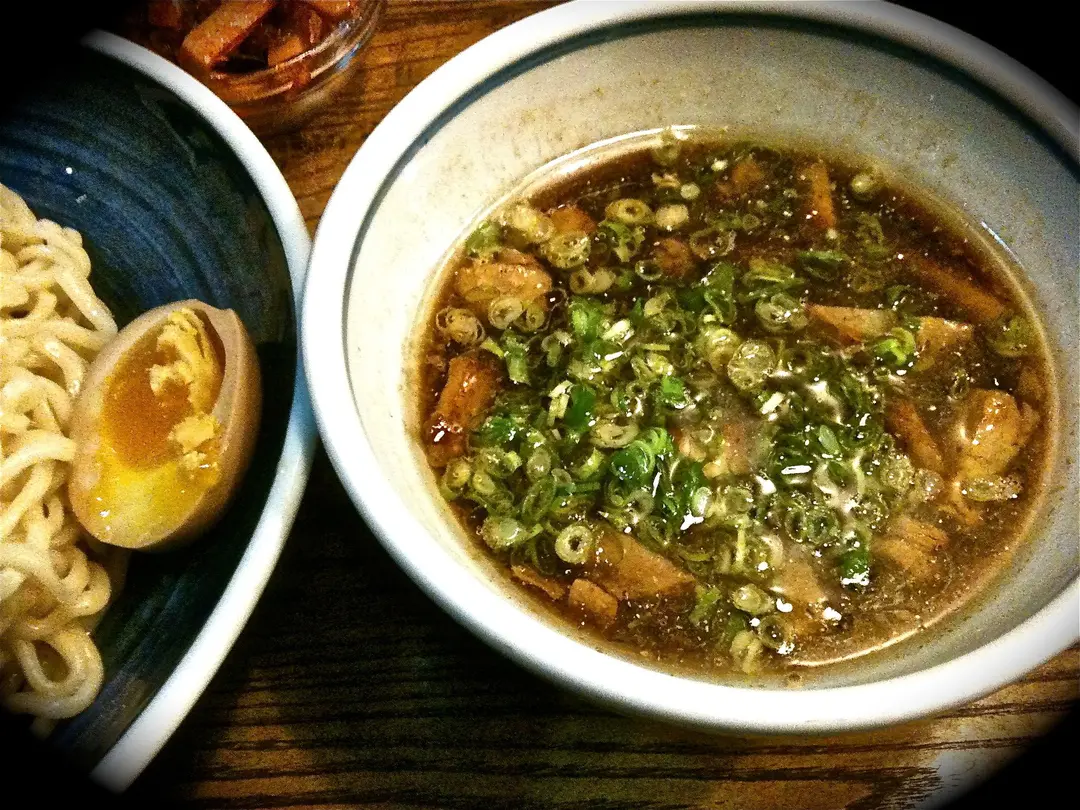 The chopped char siu - perhaps simply shredded pork cubes would be more appropriate - was quite delicious. It's about 70% lean and 30% fat. Those were quite tender and had a nice pork taste. It's chopped so, ideally, that you could eat it more easily. I find it quite hard to have the noodle together with the char siu with my chopsticks anyway. So I ate them separately. Perhaps I should just ask for a spoon instead.
The chopped char siu - perhaps simply shredded pork cubes would be more appropriate - was quite delicious. It's about 70% lean and 30% fat. Those were quite tender and had a nice pork taste. It's chopped so, ideally, that you could eat it more easily. I find it quite hard to have the noodle together with the char siu with my chopsticks anyway. So I ate them separately. Perhaps I should just ask for a spoon instead. There was also spring onions and some vinegar as well. The whole combination was quite nice. Nevertheless, it felt a little bit like a complex tempura soy sauce. Still, the noodles became softer after dipping it into the sauce and made it "bearable".
You'll be provided with a small bowl of chicken soup after you've finished the noodles. I can't say the chicken soup made much of a difference to the soy sauce mixture other than warming it up. I finished the whole bowl but still couldn't find any trace of chicken taste.
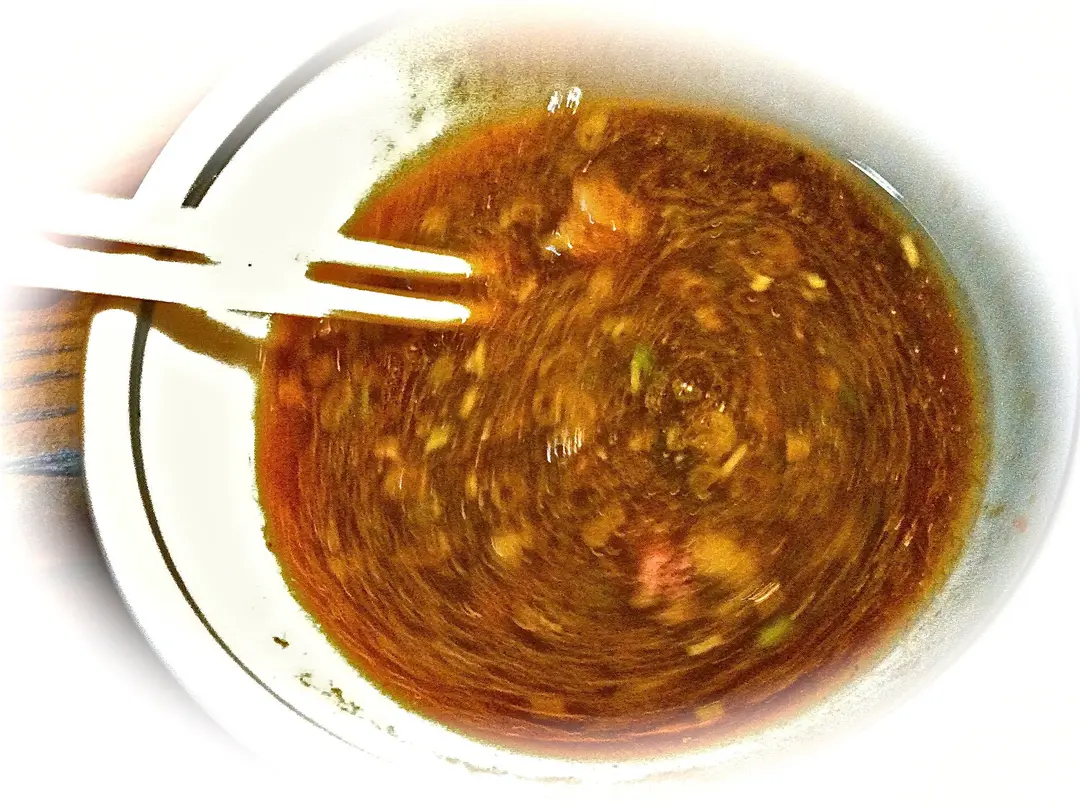 The ramen which I saw a couple next to me having appeared to be the Kyushu thin noodle inside the special soy sauce broth. That looked interesting and I wished I'd listened to my gut feeling.
The ramen which I saw a couple next to me having appeared to be the Kyushu thin noodle inside the special soy sauce broth. That looked interesting and I wished I'd listened to my gut feeling.Heavy Weight 300g:
Two ladies came and listened to the explanation provided by another female staff. They also decided to order tsukemen. Regarding the size, the staff suggested that usually, 200g was sufficient for her. After listening to that, the two ladies then said "in that case, perhaps we'll need 300g"
I was trying to wait to see their reactions when they see the 300g noodle. By sitting there, consuming my menma (which was not spicy but actually quite salty. The spring onions did not help it.), after waiting for about 10 minutes, the 300g noodles was still nowhere to be seen. So I left.
Conclusion:
The tsukemen was too hard for my taste. The egg was fine.
The soy sauce with at least 140 years history was really good. The char siu was nice and tender.
The spicy bamboo shoot was just so-so and a bit overpriced.
The bill came down to HK$123. Which I find a bit pricey.
Very good service. Comfy environment.
I'm not interested in their tsukemen anymore unless they have a much softer option.
I might consider coming here again to try out their ramen in soy sauce broth instead, if I managed to find the shop!
题外话/补充资料:
P.S.
As the couple who had the ramen left, all the staff said thank you in Japanese twice. Mister A mumbled that the couple did not give any reaction (which was true). But after arranging their chairs, they said thank you to the staff. To be fair, Mister A was very polite throughout the meal. However, if the couple heard it, it might seriously affect their mood and might have backfired against Mister A.
[i]Moral of the story:[/i] I've been in the service industry myself before, I suggest leaving complaints against rude customers for your smoke breaks, toilet breaks or lunch breaks. Keep your thoughts to yourself until at least the customers leave. Certainly, the best is to get over such small stuff and chill out!:)
What's the English name of this shop anyway? "Shu getsu"? (I'm just making this up based on the yet to be established website printed on the namecard.)
(以上食记乃用户个人意见 , 并不代表OpenRice之观点。)
张贴
 影片
影片


